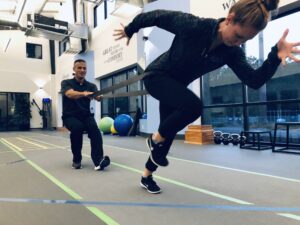Physical therapy is a practice. As with all other healthcare fields.
New studies continue to be conducted and we continue to learn from new data coming out. Statistics about various ideas in the physical therapy field constantly change old ideas into new expectations. One of my favorite professors in PT school was a guy named Tom McPoil. I had no idea that what he would say on our first day of physical therapy school would have such an impact on my career!
He said “The tests/measures, diagnosis, prognosis, etc. I teach you today is likely to be obsolete by the time you graduate in 3 years. I only hope to teach you how to find the evidence and critically appraise it.”
Again, at the time, I had no idea the impact that statement would have on me. Reading and analyzing article after article. I went through those 3 years of schooling soaking up as much knowledge as possible. It felt like I was drinking water through a fire hose.
Practicing In The Field versus The Classroom
Fast forward to post-graduation and I remember telling one of my colleagues that I was done reading articles and learning. I just wanted to start treating my patients…
That did not last long. I soon realized the importance of staying up to date with the research and knowledge that is continuously being pushed out to our community. I really noticed this when I was working at the larger physical therapy companies. Filtering in and out of patients with no clear plan of action.
We had some “dinosaur” clinicians that were treating in the clinics. Keep in mind, that this is not a jab at their age, just that their treatment techniques and style seemed to be from the dark ages. Some as a form of torture rather than technique.
Every patient had a heating pad, e-stim, and used the same old silly TheraBands at every appointment.
Often, patients would be left or forgotten on the heat pads because the technicians they were working with would get too busy or just flat out forget them.
And, for quite a few of them, they never got up and off the table to do exercises.
Standing upright did not seem like an achievable goal during the process. Week after week patients would go through the same routine without progress. Leading to more dependence on dead-end methods and physical therapy practices. Don’t we all yearn for independence in life?
It is tough to say, but I felt like, and continue to feel like, some of my colleagues are not doing right by our patients. I know some are not staying current with what the research says (and logic for that matter).
This could be for many reasons. Maybe they had the same feelings I had when I graduated about not reading another paper but weren’t able to kick that thought as I had? I am sure some felt the pressure from the “dinosaur” clinicians to stand in line and do as they were doing.
Whatever the reasons, I still see some of my colleagues stuck in this thinking. And it is 2022…
There are a few different examples of deficiencies I have seen in the physical therapy world, but I won’t list all of them. For the purpose of this blog, I wanted to get into the under-prescription of exercises in physical therapy.
2022 Physical Therapy Red Flags
TheraBands
I had mentioned that I have worked at clinics where the heaviest resistance we had was a gray TheraBand. It is ironic because this life is not full of bands. You can’t just get stronger at the maximally stretched part of the band.

The particularly frustrating about this point is that there was an initiative with the Choosing Wisely Campaign (link). This is a campaign focused on improving cost-effective care and the American Physical Therapy Association. This was provided in 2014 when the APTA gave the Choosing Wisely Campaign a list of 5 things Physical Therapists and Patients should question.
Lack of Strength Training
One of the five things to watch out for was the underdosing of strength training programs. Which is seen in a lot of clinics I have been at and seen. It is evident even on their websites and social media accounts. Undermining the use of strength programs ultimately decreases the chances of any progress being seen in your daily performance.

For those 65+ reading this, these recommendations include you and probably are more specifically including you. In fact, resistance training is a first-line intervention that is recommended by the American Geriatrics Society (link).
Our bodies are wonderful beings that can accomplish a lot! Our bodies can handle more than we realize and constantly need to be challenged with different movements. The human body is known to adapt. This occurs at every age, but we just need the stress/load to be able to do so!
The cycle goes stress-adapt-recover. We keep that cycle on repeat throughout our life.
This is why it is so frustrating when I see clinicians continue to:
– Keep people performing the same basic exercises
– Not allowing their patients to get up from the table to do exercises
– Performing completely passive treatments all the time
– Giving the same patient the same exercises for weeks on end.
Hopefully, this article has allowed you to think differently about your choice of physical therapy and why you would choose one clinic over the other.
There are many more deficiencies to be addressed at a later date in the physical therapy world.
Just remember, not all are bad!
If you are a human (assuming you are since you are reading this) and you are wondering if your body can adapt the answer is YES. If you are wondering how to help your body adapt and overcome an injury, feel free to reach out to us!
Or, feel free to download one of our free help guides to help you recover from an injury.




